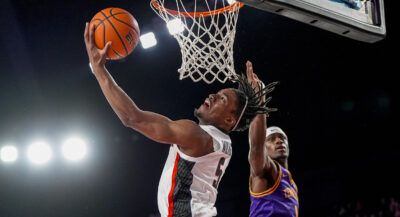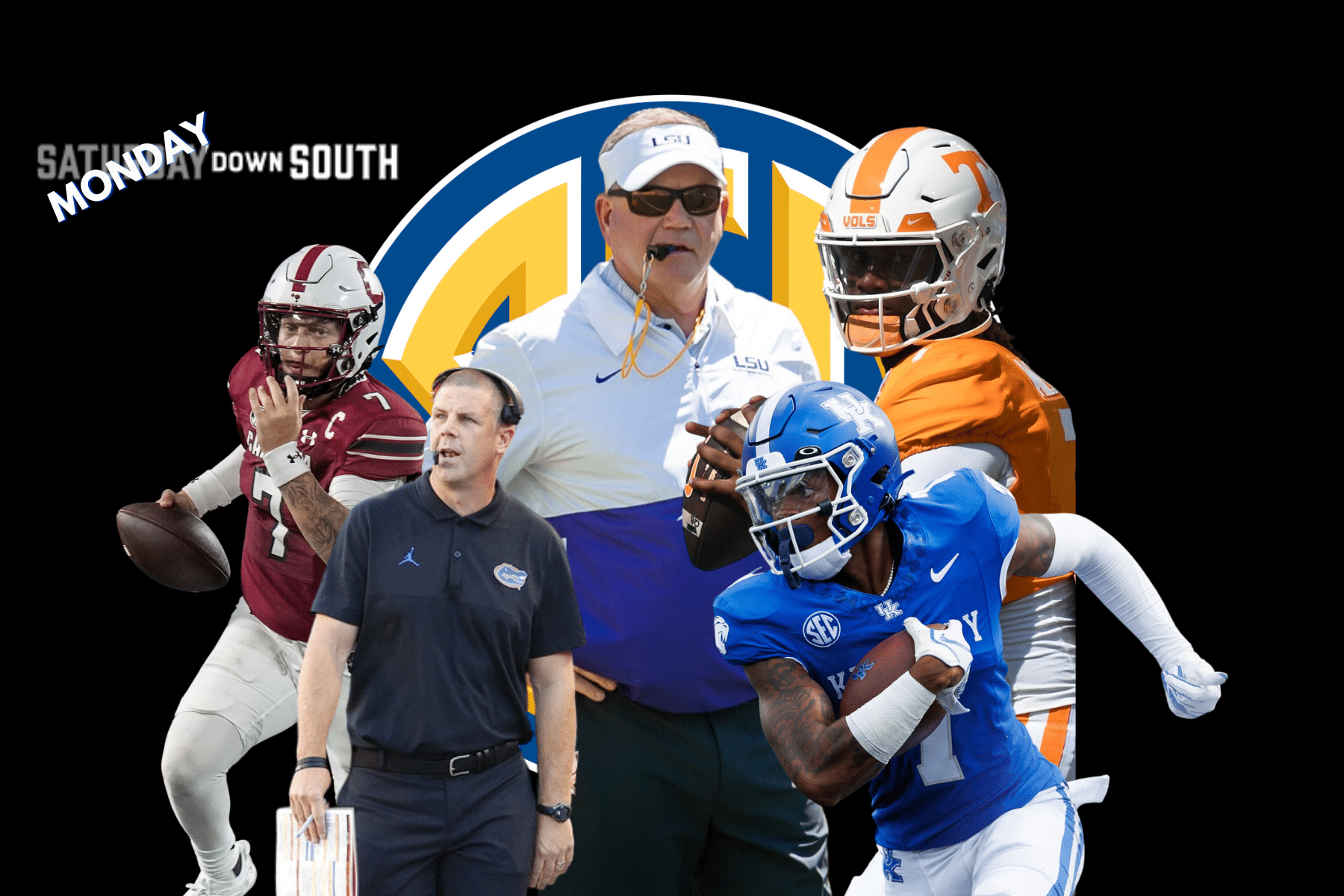The 5 biggest omissions from ESPN’s ranking of the top 25 CFB players in the 21st Century
ESPN’s Bill Connelly ventured into treacherous waters on Monday when he released a ranking of the top 25 college football players of the 21st century.
The list is overall an reasonable (at the very least) representation of college football over the past 2+ decades. However, there are some notable omissions from the list, which this piece will explore.
Important to note: Connelly chose to take on a near-impossible exercise, which he acknowledged both in the piece and while promoting it on social media. In the interest of fairness (it’s easy to list players who should have made the cut until you have to take someone off to make room), I’ve named who I would replace on Connelly’s actual list with the omissions discussed below.
With that being said, here are the 5 biggest misses from ESPN’s ranking of the top 25 college football players of the 21st century:
Michael Crabtree, Texas Tech, WR
To Connelly’s credit, Crabtree was listed amongst the 10 players who just missed the cut for ESPN’s top 25. He’s the only player named in the honorable mention section who will be written about in this story.
Crabtree’s lackluster NFL career has caused some to forget about his dominance in college, but he left Lubbock with over 3,000 receiving yards and over 40 touchdowns in just 2 seasons of play. In 2007, he went for 1,962 yards, which is 3rd all-time amongst FBS players for a single-season and the most ever for a power-conference receiver. He was also the first player ever to win 2 Biletnikoff Awards.
His numbers took a step back in 2008, but his impact didn’t. Against No. 1 Texas in 2008, Crabtree made arguably the play of the decade by tip-toeing around a Texas defensive back and into the end zone to give the Red Raiders a historic victory:
That play against the Longhorns had seismic implications on the national race. That result — coupled with Oklahoma’s beatdown of Texas Tech later in the year — meant there was a 3-way tie atop the Big 12 South standings. Texas ended up losing out to Oklahoma in the BCS rankings, with the Sooners going on to lose to Florida in the national championship game.
Crabtree couldn’t be caught, tackled or dealt with any other fashion. He’s arguably the best player the late, great Mike Leach ever coached and he deserves to be on this list.
Player to replace: Jonathan Taylor. While a remarkable running back, Taylor is somewhat-easily replaced on this list because of Wisconsin’s lack of team success while he was on campus. During his 2 Doak Walker-winning seasons in 2018 and 2019, Wisconsin went just 12-6 in Big Ten play and was never relevant in the national discussion.
Adrian Peterson, Oklahoma, RB
Injuries were somewhat of a limiting factor for Adrian Peterson in college, particularly late in his career. He only earned 1 All-America nod, but make no mistake: his freshman season at Oklahoma is arguably the best of all time.
In the 4 seasons prior to Peterson’s arrival in Norman, Oklahoma won a national championship, played for another and won an average of 12 games per year. Peterson was still so good that he immediately became the starting running back over the under-appreciated Kejuan Jones, who had rushed for 925 yards the year prior. Peterson made good on the faith shown to him by the coaching staff, rushing for 1,925 yards as a true freshman.
It’s fair to wonder if Peterson would have won the Heisman had the “freshman curse” been broken by the time he got to Norman in 2004. Peterson and teammate Jason White finished 2nd and 3rd behind USC’s Matt Leinart in 2004. Leinart was the leader of a special era of USC football, but his numbers in ’04 were relatively unspectacular when compared to what Peterson was doing as a true freshman.
Peterson ultimately ended up leaving Oklahoma as the program’s second all-time leading rusher after just 2.5 seasons of action. A collarbone injury suffered in 2006 limited him to just 7 games as a junior. But he still left OU with over 4,000 rushing yards, 3 1,000-yard rushing campaigns, 41 rushing touchdowns and one of the most violent highlight packages the sport has seen from a running back:
Player to replace: Kyler Murray. Peterson would make 4 Oklahoma players (along with Baker Mayfield and Roy Williams), so it only seems fair to knock out a Sooner to make room for Peterson. Murray only had 1 standout year in college as he sat behind Mayfield after transferring.
Johnny Manziel, Texas A&M, QB
Manziel didn’t make the cut as one of the sport’s best 25 players of the 21st century, but he probably should have. And he’s definitely one of the most memorable talents the sport has produced in the last quarter century.
Manziel took the sport by storm when he upset Alabama in 2012 and rode that momentum all the way to the Heisman Trophy. His numbers from that season are incredible: 3,706 passing yards, 26 passing touchdowns, 1,410 rushing yards and 21 rushing scores.
In 2013, Manziel was even more efficient as a passer (although less so as a runner) and ended up becoming a first-round pick in the following NFL Draft. His pro career failed for any number of reasons that won’t — and shouldn’t — be considered when evaluating his contributions to the college game.
Player to replace: Tyrann Mathieu. Like Manziel, Mathieu played just 2 collegiate seasons. Mathieu was certainly productive (and memorable) on both defense and special teams, but Manziel is one of the defining players in college football for the 2010s. I think he has to be on the list, even if it’s at Mathieu’s expense.
James Laurinaitis, LB, Ohio State
Connelly’s list is lacking Big Ten flavor, for better or worse. The only players on the original top 25 that played Big Ten football are ex-Wisconsin stars. Putting Laurinaitis into the top 25 fixes that flaw and rewards an all-time great linebacker who is certainly worth inclusion based on his own merit.
Laurinaitis won individual awards in 3 separate seasons. He won the Bronko Nagurski Trophy in 2006, the Lombardi Award in 2007 and the Lott Trophy in 2008. He was also a 3-time All-American and a 2-time Big Ten Defensive Player of the Year Award winner.
He was also a leader on an Ohio State team that played for a couple of national championships, although the Buckeyes lost both. He left Columbus with 24.5 tackles for loss, 13 sacks and 9 interceptions in 3+ years of play.
Player to replace: David Pollack. Laurinaitis and Pollack are both 3-time All-Americans whose trophy cabinets are chock-full of hardware. Pollack was a key part of some early Mark Richt teams that won 10+ games in Athens, but I’d give the nod to Laurinaitis because of the impact he made on some of Jim Tressel’s best teams.
Ja’Marr Chase, WR, LSU
Ja’Marr Chase only had 1 great season at LSU, but boy was it great. In 2019, Chase exploded for 1,780 yards, 20 touchdowns and was an integral part of LSU’s national championship-winning team. Along with Joe Burrow, Chase has a case for being the most talented player on arguably the best offense of the 21st century.
During that historic 2019 season, Chase had 7 games where he recorded 140+ receiving yards and 3 contests of 200+ receiving yards. He was as unstoppable as any receiver has been in the modern era.
Chase saved arguably his best game for last. In the national championship game against Trevor Lawrence and Clemson, Chase caught 9 passes for 221 yards and 2 touchdowns. He was the biggest difference-maker in LSU’s 42-25 win over Clemson, clinching one of the most dominant undefeated title runs in recent memory.
Chase’s teammate, wide receiver Justin Jefferson, also has a case for being included on this list.
Looking to join a sportsbook in Louisiana this summer? Here’s a bet365 Louisiana promo to help you get started with one of the best sportsbooks on the market!
Player to replace: Khalil Mack. What Mack accomplished at Buffalo was remarkable, but at the end of the day, he spent 4 years beating up on offensive linemen from the MAC. The level of competition he faced at Buffalo was several rungs below that of every other player on Connelly’s list. To his credit, he was also productive in his few opportunities against power-conference opponents (including a 2.5-sack game against Ohio State), but it’s not enough volume to justify his inclusion on this list over someone like Chase.
Other omissions worth considering
In no particular order…
- Darren McFadden
- Marcus Mariota
- Jameis Winston
- Derrick Henry
- Robert Griffin III
- Luke Kuechly
- Trevor Lawrence
- Christian McCaffrey
- Von Miller
- Justin Jefferson
- Ezekiel Elliott
- Sam Bradford
- Matt Leinart
- Saquon Barkley
- Kellen Moore
- Manti T’eo
If you’re going by pure individual accolades and success, McFadden is the name that stands out the most. He rushed for over 4,500 yards in 3 years with the Razorbacks and finished as Heisman Trophy runner-up twice. McFadden carried Arkansas to a 10-win season in 2006 — 1 of just 3 such campaigns for Arkansas since the turn of the century. Aside from the national title winners, those Arkansas teams were amongst the most memorable from that decade of college football.
Winston, Mariota, Griffin, Bradford and Leinart all have a right to feel snubbed given that they were all multi-year starters on winning teams who also won Heisman Trophies. Winston and Leinart are perhaps the most aggrieved of that group, given that they won national championships while the others did not.
Jefferson, Elliott, Henry and Lawrence all won national championships as well and certainly deserve consideration. Players like McCaffrey, Miller, Barkley, Moore and Kuechly all put up gaudy stats, but didn’t reach the level of team success necessary to make the cut.
Spenser is a news editor for Saturday Down South and covers college football across all Saturday Football brands.






